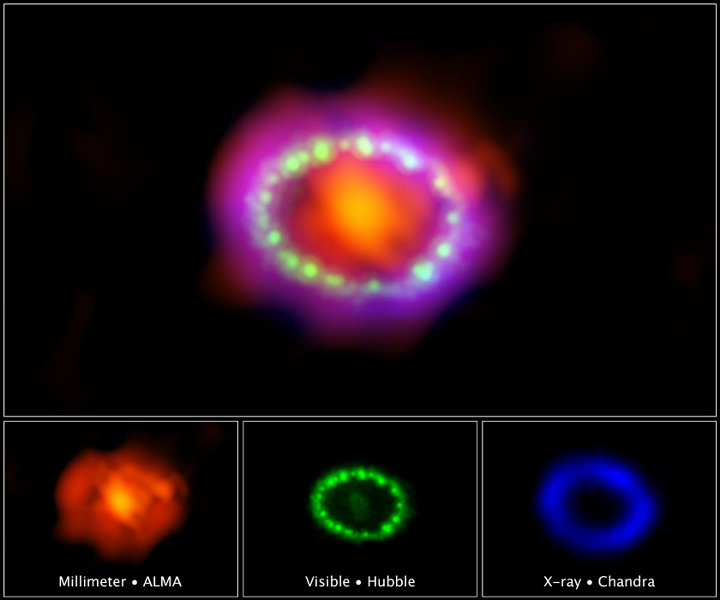
 Credit: X-ray: NASA/CXC/SAO/PSU/K.Frank et al.; Optical: NASA/STScI; Millimeter: ESO/NAOJ/NRAO/ALMA
Credit: X-ray: NASA/CXC/SAO/PSU/K.Frank et al.; Optical: NASA/STScI; Millimeter: ESO/NAOJ/NRAO/ALMA
Commemorating SN 1987a
February 24th marked the thirtieth anniversary of the explosion of Sanduleak -69 202, a massive blue star in the Large Magellanic Cloud, one of the Milky Way's satellite galaxies. The explosion was the first supernova of that year, and so the event was named SN 1987a. This was the closest supernova explosion in over four centuries, easily visible with the unaided eye, and the first local supernova of the modern era of astronomy. For the first time astronomers could study the precise details of a supernova with large ground-based telescopes, and satellite observatories as well. Early realizations - the blue color of the progenitor; the three rings lit up by the explosion; and no detection of a compact object at the center - were especially shocking. Since 1987, this supernova has been observed by nearly every available ground-based and satellite observatory which could view the LMC. Space-based observations were first made with the Soviet Astron observatory and the International Ultraviolet Explorer in the ultraviolet, then soon by the Hubble Space Telescope (newly launched in 1990) in the optical and UV. High energy emission was observed by ROSAT (also launched in 1990) in the X-ray region, and since then with large satellite observatories like the Chandra X-ray Observatory and XMM-Newton, and in hard X-rays and Gamma-rays using INTEGRAL, the Fermi Gamma-ray Space Telescope, and NuSTAR. The explosion was even detected by neutrino detectors on earth, which saw a burst of neutrinos produced deep within the exploding star a few hours before the visible light from the explosion was seen. The image above is a 30-year anniversary composite image of the baby supernova remnant comprised of an X-ray image from Chandra, an HST optical image, and a millimeter wavelength image from ground by the ALMA observatory. The ring-like emission seen in X-rays and optical is produced as light and matter from the explosion plows into pre-existing material ejected from the progenitor star sometime in its past. Continuing studies of SN 1987a provide astronomers the unique opportunity to view the evolution of a supernova remnant in real time, and furthers our understanding of how supernovae enrich their host galaxies with the chemical elements needed for life.
Published: March 6, 2017
<
HEA Dictionary ● Archive
● Search HEAPOW
● Other Languages
● HEAPOW on Facebook
● Download all Images
● Education ● HEAD
>

Each week the HEASARC
brings you new, exciting and beautiful images from X-ray and Gamma ray
astronomy. Check back each week and be sure to check out the HEAPOW archive!
Page Author: Dr. Michael F. Corcoran
Last modified Monday, 26-Feb-2024 17:46:57 EST


